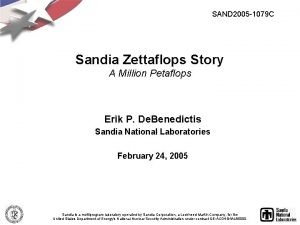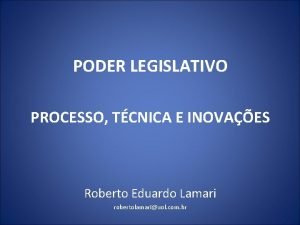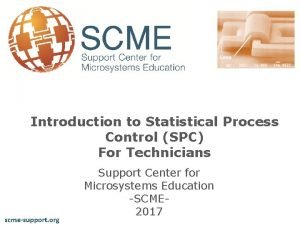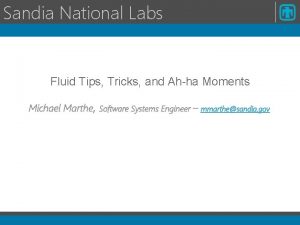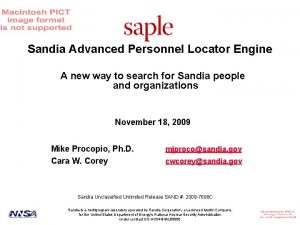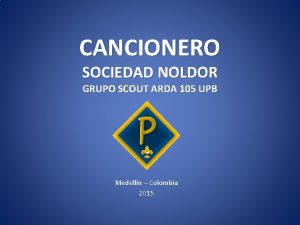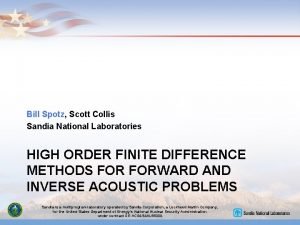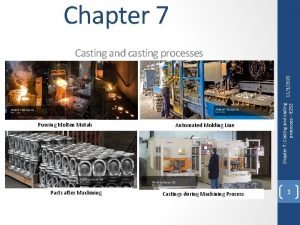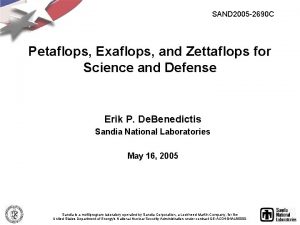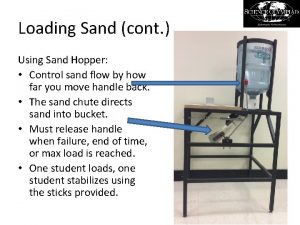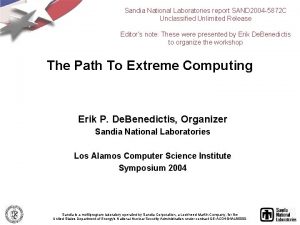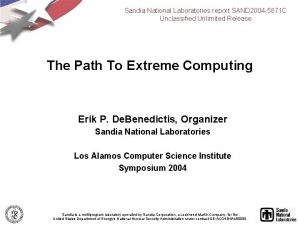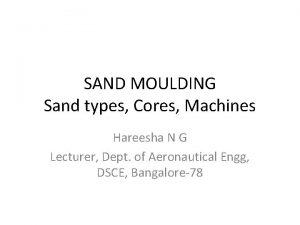SAND 2005 1079 C Sandia Zettaflops Story A



















- Slides: 19

SAND 2005 -1079 C Sandia Zettaflops Story A Million Petaflops Erik P. De. Benedictis Sandia National Laboratories February 24, 2005 Sandia is a multiprogram laboratory operated by Sandia Corporation, a Lockheed Martin Company, for the United States Department of Energy's National Nuclear Security Administration under contract DE-AC 04 -94 AL 85000.

Applications and $100 M Supercomputers System Performance 1 Zettaflops Applications Plasma Fusion Simulation [Jardin 03] 100 Exaflops 1 Exaflops No schedule provided by source Full Global Climate [Malone 03] MEMS Optimize Nanotech + Reversible Logic m. P (green) best-case logic (red) Compute as fast as the engineer can think [NASA 99] 100 Petaflops 100 Teraflops 2000 Technology Architecture: IBM Cyclops, FPGA, PIM Red Storm/Cluster 1000 [SCa. Le. S 03] 2010 2020 2000 2010 2020 2030 Year [Jardin 03] S. C. Jardin, “Plasma Science Contribution to the SCa. Le. S Report, ” Princeton Plasma Physics Laboratory, PPPL-3879 UC-70, available on Internet. [Malone 03] Robert C. Malone, John B. Drake, Philip W. Jones, Douglas A. Rotman, “High-End Computing in Climate Modeling, ” contribution to SCa. Le. S report. [NASA 99] R. T. Biedron, P. Mehrotra, M. L. Nelson, F. S. Preston, J. J. Rehder, J. L. Rogers, D. H. Rudy, J. Sobieski, and O. O. Storaasli, “Compute as Fast as the Engineers Can Think!” NASA/TM-1999 -209715, available on Internet. [SCa. Le. S 03] Workshop on the Science Case for Large-scale Simulation, June 24 -25, proceedings on Internet a http: //www. pnl. gov/scales/. [De. Benedictis 04], Erik P. De. Benedictis, “Matching Supercomputing to Progress in Science, ” July 2004. Presentation at Lawrence Berkeley National Laboratory, also published as Sandia National Laboratories SAND report SAND 2004 -3333 P. Sandia technical reports are available by going to http: //www. sandia. gov and accessing the technical library.

Outline • An Exemplary Zettaflops Problem • The Limits of Moore’s Law • Beyond Moore’s Law – Industry’s Plans – Nanotech and Reversible Logic • Conclusions

FLOPS Increases for Global Climate Issue Scaling 1 Zettaflops Ensembles, scenarios 10 Embarrassingly Parallel 100 Exaflops Run length 100 Longer Running Time 1 Exaflops New parameterizations 100 More Complex Physics 10 Petaflops Model Completeness 100 More Complex Physics 100 Teraflops Spatial Resolution 104 (103 -105 ) Resolution 10 Gigaflops Clusters Now In Use (100 nodes, 5% efficient) Ref. “High-End Computing in Climate Modeling, ” Robert C. Malone, LANL, John B. Drake, ORNL, Philip W. Jones, LANL, and Douglas A. Rotman, LLNL (2004)

Exemplary Exa- and Zetta-Scale Simulations • Sandia MESA facility using MEMS for weapons • Heat flow in MEMS not diffusion; use DSMC for phonons • Shutter needs 10 Exaflops on an overnight run for steady state • Geometry optimization 100 Exaflops overnight run – Adjust spoke width for high b/w no melting 500 mm

FLOPS Increases for MEMS Issue Scaling 100 Exaflops Optimize 10 Sequential 10 Exaflops Run length 300 Longer Running Time 30 Petaflops Scale to 500 mm 2 12 mm disk 50, 000 Size 600 Gigaflops 2 D 3 D 120 Size 5 Gigaflops 2 mm. 5 mm 3 ms 2 D film 10 1. 2 GHz PIII

Outline • An Exemplary Zettaflops Problem • The Limits of Moore’s Law • Beyond Moore’s Law – Industry’s Plans – Nanotech and Reversible Logic • Conclusions

*** This is a Preview *** Best-Case Logic 2 1024 Microprocessor Architecture logic ops/s Physical Factor Source of Authority Reliability limit 750 KW/(80 k. BT) Esteemed physicists (T=60°C junction temperature) Derate 20, 000 convert Floating point engineering (64 bit precision) logic ops to floating point Expert Opinion 100 Exaflops Estimate 25 Exaflops 200 Petaflops 4 Exaflops 32 Petaflops 1 Exaflops 8 Petaflops 800 Petaflops 125: 1 Assumption: Supercomputer 80 Teraflops is size & cost of Red Storm: US$100 M budget; consumes 2 MW wall power; 750 KW to active components 40 Teraflops Derate for manufacturing margin (4 ) Estimate Uncertainty (6 ) Gap in chart Improved devices (4 ) Estimate Projected ITRS committee of experts improvement to 22 nm (100 ) Lower supply voltage ITRS committee of experts (2 ) Red Storm contract

Metaphor: FM Radio on Trip to Austin • You drive to Austin listening to FM radio • Music clear for a while, but noise creeps in and then overtakes music • Analogy: You live out the next dozen years buying PCs every couple years • PCs keep getting faster – clock rate increases – fan gets bigger – won’t go on forever • Why…see next slide Details: Erik De. Benedictis, “Taking ASCI Supercomputing to the End Game, ” SAND 2004 -0959

FM Radio and End of Moore’s Law Distance Driving away from FM transmitter less signal Noise from electrons no change Shrink Increasing numbers of gates less signal power Noise from electrons no change

Scientific Supercomputer Limits Best-Case Logic 2 1024 Microprocessor Architecture logic ops/s Physical Factor Source of Authority Reliability limit 750 KW/(80 k. BT) Esteemed physicists (T=60°C junction temperature) Derate 20, 000 convert Floating point engineering (64 bit precision) logic ops to floating point Expert Opinion 100 Exaflops Estimate 25 Exaflops 200 Petaflops 4 Exaflops 32 Petaflops 1 Exaflops 8 Petaflops 800 Petaflops 125: 1 Assumption: Supercomputer 80 Teraflops is size & cost of Red Storm: US$100 M budget; consumes 2 MW wall power; 750 KW to active components 40 Teraflops Derate for manufacturing margin (4 ) Estimate Uncertainty (6 ) Gap in chart Improved devices (4 ) Estimate Projected ITRS committee of experts improvement to 22 nm (100 ) Lower supply voltage ITRS committee of experts (2 ) Red Storm contract

Outline • An Exemplary Zettaflops Problem • The Limits of Moore’s Law • Beyond Moore’s Law – Industry’s Plans – Nanotech and Reversible Logic • Conclusions

Proceeding • So industry has plans to extend Moore’s Law, right? – Next slide shows ITRS Emerging Research Devices (ERD), the devices under consideration by industry – All are either hotter, bigger, or slower – Erik is now on ITRS ERD committee • What is scientifically feasible for Gov’t funding? – Nanotechnology • Efforts all over – Reversible logic • Odd name for a method of cutting power below k. B T • Not currently embraced by industry

ITRS Device Review 2016 Shaded = Slower Larger Hotter

Outline • An Exemplary Zettaflops Problem • The Limits of Moore’s Law • Beyond Moore’s Law – Industry’s Plans – Nanotech and Reversible Logic • Conclusions

An Exemplary Device: Quantum Dots • Pairs of molecules create a memory cell or a logic gate Ref. “Clocked Molecular Quantum-Dot Cellular Automata, ” Craig S. Lent and Beth Isaksen IEEE TRANSACTIONS ON ELECTRON DEVICES, VOL. 50, NO. 9, SEPTEMBER 2003

Atmosphere Simulation at a Zettaflops Supercomputer is 211 K chips, each with 70. 7 K nodes of 5. 77 K cells of 240 bytes; solves 86 T=44. 1 Kx 44. 1 K cell problem. System dissipates 332 KW from the faces of a cube 1. 53 m on a side, for a power density of 47. 3 KW/m 2. Power: 332 KW active components; 1. 33 MW refrigeration; 3. 32 MW wall power; 6. 65 MW from power company. System has been inflated by 2. 57 over minimum size to provide enough surface area to avoid overheating. Chips are at 99. 22% full, comprised of 7. 07 G logic, 101 M memory decoder, and 6. 44 T memory transistors. Gate cell edge is 34. 4 nm (logic) 34. 4 nm (decoder); memory cell edge is 4. 5 nm (memory). Compute power is 768 EFLOPS, completing an iteration in 224µs and a run in 9. 88 s.

Outline • An Exemplary Zettaflops Problem • The Limits of Moore’s Law • Beyond Moore’s Law – Industry’s Plans – Nanotech and Reversible Logic • Conclusions

Conclusions • Important applications exist to 1 Zettaflops • Performance of $100 M m. Pbased supercomputers will rise to only ~100 Petaflops – This would meet current ASC demand – Will take decades to reach this level – But then again, 100 Teraflops was supposed to as well • Advanced Architectures (e. g. PIM) will rise to ~10 Exaflops – Sandia has proposal outstanding to deploy Cyclops PIM-based system • Nanotech and Reversible logic good to perhaps 1 Zettaflops
 Zettaflops
Zettaflops Lei 1079/50 art 39
Lei 1079/50 art 39 Chemsheets as 1079
Chemsheets as 1079 Residual chlorine
Residual chlorine Perbedaan rapid sand filter dan slow sand filter
Perbedaan rapid sand filter dan slow sand filter Frictional force definition
Frictional force definition Green sand casting definition
Green sand casting definition Sandia
Sandia Incidente de la tajada de sandia
Incidente de la tajada de sandia Sandia vista elementary school
Sandia vista elementary school Rima de queso y hueso
Rima de queso y hueso Sandia lakes
Sandia lakes Sandia labs
Sandia labs Cubit sandia
Cubit sandia Sandia techweb
Sandia techweb En las noches cuando la luna como plata se eleva
En las noches cuando la luna como plata se eleva Julia phillips sandia
Julia phillips sandia Scott collis sandia
Scott collis sandia The story tells about
The story tells about Sand mold casting
Sand mold casting
